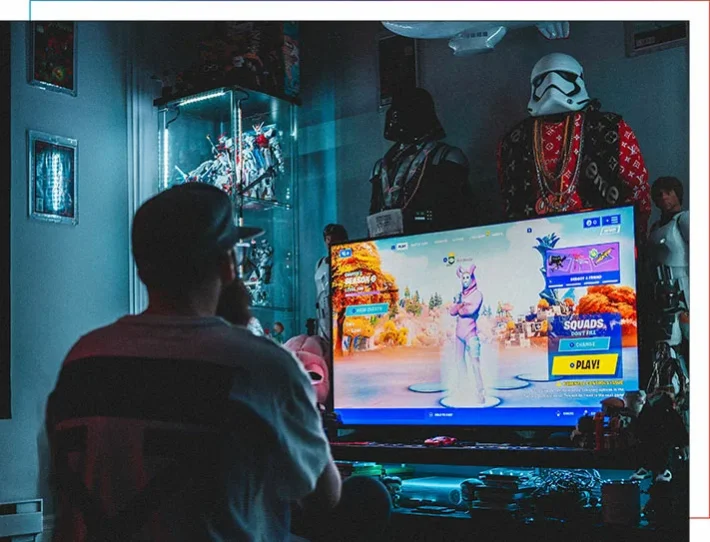Strategie
How marketers can use games as touchpoints

You’ve probably encountered at least one of the following headlines in recent years. For
example, that Gamescon, the annual trade fair for video games, is now one of the most visited trade fairs in the world with almost 400,000 visitors each year. Or that with annual revenues of around 150 billion U.S. dollars (2020), the gaming industry has outpaced all other media and entertainment industries (with the exception of TV), including cinema, the book industry and subscription streaming services. New consoles and graphics cards sell out in record time with many sold out to this day due to record demand (and the ongoing chip shortage many industries are currently grappling with). Rumour has it that some people who pre-ordered a Playstation 5 are still waiting to receive it 1.5 years later.
From a niche hobby to one of the world’s leading industries
Developing AAA games requires years of work by hundreds of employees, now costing in the region of 100 million U.S. dollars and above. Top games generate several billion dollars in revenue over the years. The most successful media franchise ever, Pokémon, which started out as a gameboy game, has achieved revenues of 118 billion U.S dollars. In other words, the niche hobby for nerds often viewed with scepticism a few years back is now one of the world's most important industries.
In spite of this, marketers still tend to focus on product placements in films (just ask yourself which watch James Bond wears?) and classic TV ads (I’m sure you could tell me where to go if my windscreen has a chip?). The potential games hold as touchpoints is far too often overlooked. With this in mind, I plan to explore the main marketing options offered by games in this article.
Three types of games relevant to marketing
A game is never just a game. Let’s clear that up from the off. As I feel particularly strongly about this point, I’ll provide a little more information. Just like film and TV, games differ in their approaches and objectives just as much as arthouse cinema, the latest Marvel superhero blockbuster and trash TV like “I’m a Celebrity”.
Mobile Games
The major difference with games often comes from the device they're played on. Due to lower processing power (now not such a crucial factor, but historically an issue) and smaller screens, mobile games for smartphones are often very different to games for consoles and PCs.
Mobile games often provide calculated busywork compressed into game form to keep users happy. And yes, they’re usually pretty fun. That’s the entire point! But it’s important to keep in mind that these games are solely designed to keep users playing with psychological tricks and generate as much income as possible through various monetisation tools. Free-to-play games are rarely what they say on the tin. Lots of mobile games are free to start with. However, in order to (quickly) advance in the game or improve, players need to dish out cash in microtransactions. It could be the occasional €0.99 spent or perhaps €2.99 from time to time. The rewarding experience motivates players to spend a little more each time, which can quickly add up.
Another – in my opinion fairer – way to make money with mobile games is to utilise in-game advertising. It’s as simple as it sounds: players regularly encounter ads in the game. Ads can take on a number of forms, which we’ll look at later. Finally, it's important to clarify that there are many creative smartphone games out there smartly developed with the user in mind, regardless of their monetisation model. Competitors using more questionable tactics are the ones making it hard for consumers to know which kind of game they are looking at.

Consoles and PC games
In my opinion, the most playable types of games are designed for consoles or PCs. Sure,
you’ll also encounter free-to-play games following a similar approach to mobile games. But console and PC games typically conform to a much more standardised approach: Pay a one-time fee of €20 to €70 to purchase the game and play as many times as you want without ads or needing to spend money when playing.
However, the trend is moving towards a merger of different monetisation models. Even AAA productions that command a €70 price tag are increasingly incorporating in-game stores where players can purchase items for hard cash. As it currently stands, the items available for purchase aren’t generally anything fundamental to the game but instead cosmetic (a new outfit for you character, etc.). Side note: Football simulation game FIFA by Electronic Arts (EA) often lands in hot water for its monetisation practices. A deep dive into this issue would go beyond the scope of this article.
But I’ll say this for now: Console and PC games are generally top quality products developed with love over the course of years. However, in recent years, bad working conditions, compulsory overtime marathons before a release (known as crunch time in the industry) and burnouts are increasingly dominating headlines on the industry while console and PC games remain at the forefront of the industry as top products, often even as true works of art produced by the entertainment industry.
Marketing games
Now we’ll take a look at different ad formats in games and their various advantages and disadvantages. The transitions between different ad formats may be a little rough around the edges and I’m bound to have missed certain advantages and disadvantages, but the following section should provide an adequate overview and highlight the relevance of each format. Marketers may hopefully get one or two ideas about how a game could serve as a touchpoint for their brand or product.
Ad breaks
Just like on TV or YouTube, games can be interrupted at set points (e.g. after completing a certain task). Players then watch a video or display ad. The advertising spaces aren’t static, but can be dynamically adapted. Marketers can book these ad spots similarly to display ads or pre-roll ads (ads that play at the start of a YouTube video). This ad format is almost exclusively used for mobile games.
Dynamic In-Game Advertising
This ad format is the natural progression from the ad breaks described above. With dynamic
in-game advertising, ad spaces that can be booked by marketers are created in the game world itself and more or less naturally integrated. For example, one approach could be placing ad banners in virtual football stadiums. In this scenario, the ad banners make the football simulation more realistic by mimicking what we experience at football games in the real world. Racing games often adopt a similar approach with billboards on buildings seen by players as they whiz through the city. Similarly to DOOH ad spaces, these virtual ad spaces can also be booked by marketers.werden.
Product placements and static in-game advertising
The inclusion of brands and products in games offers real added value. Particularly with product placement in simulations. This can be seen in everything from football simulations where players can be dressed in the latest Adidas or Nike trainers, racing simulations where players can drive brand new Porsche or Ferrari racing cars, to life simulation games like The Sims where players can furnish their house with the latest Ikea furniture. Static in-game advertising works in a similar way. Similarly to dynamic in-game advertising, this ad format is comparable to classic advertising and doesn’t display the product itself, merely an ad for the product or brand. The difference lies in the fixed integration of the ad element in the game, meaning it can’t be replaced (well, only with patch updates to the game).
Creative Placements
The relatively little-known term ‘creative placement’ originally comes from product
placement in the film industry and describes a particularly aggressive form of product
placement. In this scenario, a product or brand is creatively and actively incorporated into the plot of the game. The following example can be used for both the game and film industry: A character/player is tasked with stealing the latest prototypes of a car from a certain brand and then evading the police in a car chase using superior technology and performance.
What lies in store?
We can most likely expect to see a rise in brand and product communication in games, be it through dynamic advertising, product placement or – increasingly, in my opinion – creative placements. The advantages to games as spaces to project brand communication will likely become particularly evident in VR. Sure, VR is currently experiencing a lot of hype. Three years ago, some remained convinced that VR glasses would replace TV, travel, social interactions and even work in the real world. Then the pandemic came along and everything (paradoxically) went silent regarding VR, leading us once again to disappointment.
And then the promise of a metaverse arrived – seemingly out of nowhere. Anyone familiar with Ready Player One by Steven Spielberg (or the book), can only imagine what themetaverse could look like. The film includes an interesting quote on the topic of ads in the metaverse that is of course a little exaggerated for theatrics: ‘We think we can sell up to 80% of an individual‘s visual field before inducing seizures.’ On that note: Good game.


A passionate professor in his spare time, Gilles is keen to integrate academic findings into communication strategies. At port-neo, he works as a customer experience consultant along with other responsibilities in brand and content strategy, breathing new life into target group and market analyses.
